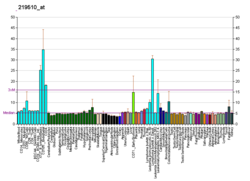DNA polymerase theta is an enzyme that in humans is encoded by the POLQ gene.[5][6] This polymerase plays a key role in one of the three major double strand break repair pathways: theta-mediated end joining (TMEJ).[7][8][9][10] Most double-strand breaks are repaired by non-homologous end joining (NHEJ) or homology directed repair (HDR). However, in some contexts, NHEJ and HR are insufficient and TMEJ is the only solution to repair the break.[11] TMEJ is often described as alternative NHEJ, but differs in that it lacks a requirement for the Ku heterodimer, and it can only act on resected DNA ends.[12] Following annealing of short (i.e., a few nucleotides) regions on the DNA overhangs, DNA polymerase theta catalyzes template-dependent DNA synthesis across the broken ends, stabilizing the paired structure.[13][14]
- ^ a b c GRCh38: Ensembl release 89: ENSG00000051341 – Ensembl, May 2017
- ^ a b c GRCm38: Ensembl release 89: ENSMUSG00000034206 – Ensembl, May 2017
- ^ "Human PubMed Reference:". National Center for Biotechnology Information, U.S. National Library of Medicine.
- ^ "Mouse PubMed Reference:". National Center for Biotechnology Information, U.S. National Library of Medicine.
- ^ Sharief FS, Vojta PJ, Ropp PA, Copeland WC (July 1999). "Cloning and chromosomal mapping of the human DNA polymerase theta (POLQ), the eighth human DNA polymerase". Genomics. 59 (1): 90–6. doi:10.1006/geno.1999.5843. PMID 10395804.
- ^ "Entrez Gene: POLQ polymerase (DNA directed), theta".
- ^ Chan SH, Yu AM, McVey M (July 2010). "Dual roles for DNA polymerase theta in alternative end-joining repair of double-strand breaks in Drosophila". PLOS Genetics. 6 (7): e1001005. doi:10.1371/journal.pgen.1001005. PMC 2895639. PMID 20617203.
- ^ Yu AM, McVey M (September 2010). "Synthesis-dependent microhomology-mediated end joining accounts for multiple types of repair junctions". Nucleic Acids Research. 38 (17): 5706–17. doi:10.1093/nar/gkq379. PMC 2943611. PMID 20460465.
- ^ Koole W, van Schendel R, Karambelas AE, van Heteren JT, Okihara KL, Tijsterman M (2014-02-05). "A Polymerase Theta-dependent repair pathway suppresses extensive genomic instability at endogenous G4 DNA sites". Nature Communications. 5 (1): 3216. Bibcode:2014NatCo...5.3216K. doi:10.1038/ncomms4216. PMID 24496117.
- ^ Roerink SF, van Schendel R, Tijsterman M (June 2014). "Polymerase theta-mediated end joining of replication-associated DNA breaks in C. elegans". Genome Research. 24 (6): 954–62. doi:10.1101/gr.170431.113. PMC 4032859. PMID 24614976.
- ^ Schimmel J, van Schendel R, den Dunnen JT, Tijsterman M (September 2019). "Templated Insertions: A Smoking Gun for Polymerase Theta-Mediated End Joining". Trends in Genetics. 35 (9): 632–644. doi:10.1016/j.tig.2019.06.001. PMID 31296341. S2CID 195892718.
- ^ Yousefzadeh MJ, Wyatt DW, Takata K, Mu Y, Hensley SC, Tomida J, et al. (October 2014). "Mechanism of suppression of chromosomal instability by DNA polymerase POLQ". PLOS Genetics. 10 (10): e1004654. doi:10.1371/journal.pgen.1004654. PMC 4183433. PMID 25275444.
- ^ Mateos-Gomez PA, Gong F, Nair N, Miller KM, Lazzerini-Denchi E, Sfeir A (February 2015). "Mammalian polymerase θ promotes alternative NHEJ and suppresses recombination". Nature. 518 (7538): 254–7. Bibcode:2015Natur.518..254M. doi:10.1038/nature14157. PMC 4718306. PMID 25642960.
- ^ Ceccaldi R, Liu JC, Amunugama R, Hajdu I, Primack B, Petalcorin MI, et al. (February 2015). "Homologous-recombination-deficient tumours are dependent on Polθ-mediated repair". Nature. 518 (7538): 258–62. Bibcode:2015Natur.518..258C. doi:10.1038/nature14184. PMC 4415602. PMID 25642963.





